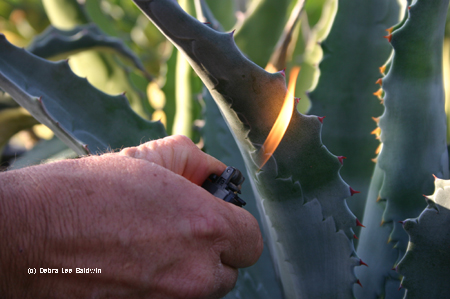
Wildfires making national news are a wake-up call for us Southern Californians who live near canyons and wilderness areas. Hot Santa Ana winds blow from the desert, desiccating already stressed plants and threatening to push backcountry brush fires all the way to the sea. We’ve had no rain for months and everything is tinder-dry.
My husband and I were evacuated from our home near San Diego during the wildfires of 2007. It was just a precaution; the fire never came closer than 11 miles. But for several days, while at our son’s house, we watched the news and wondered about the wind. Had it died down? Which direction was it coming from?
After we returned and unpacked two cars loaded with irreplaceables, I read an email from Suzy Schaefer, with the subject line “Succulents saved our home!” Suzy is the owner of the garden on the cover of my book, Designing with Succulents. The next day, I visited the Schaefer garden in Rancho Santa Fe and took photos. The story was picked up by the Associated Press, I wrote an article about it for the Los Angeles Times (which is on my website) and Suzy and I were on local television, discussing why succulents are so remarkably fire-retardant.
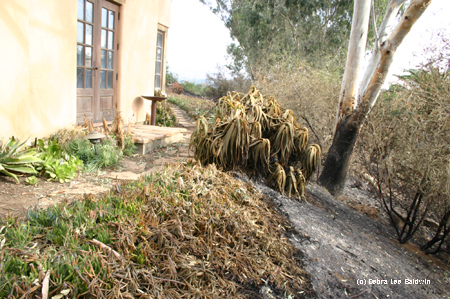
The wildfire came down a canyon near Suzy’s art studio (left). A succulent groundcover stopped the flames and a stand of Aloe arborescens (center) shielded the structure. The collapsed leaves protected the plant’s vital inner core, which remained green despite the fire’s intense heat.

This is what the canyon looked like the day after the fire. A home across the street burned to the ground.
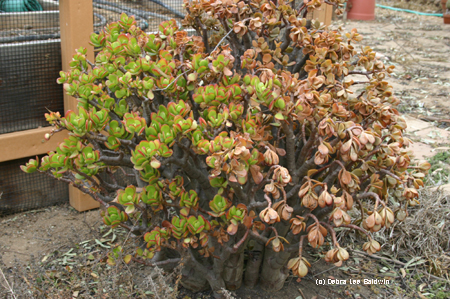
This jade plant (Crassula ovata) was in the Schaefer garden. Ironically, the scorched branches look like frost damage. Succulents by definition are plants that withstand drought by storing water in fleshy leaves and stems. This makes them slow to catch on fire. Consequently, they’re good perimeter plants for gardens in fireprone areas.

I took this photo the same day in the nearby community of Del Dios, which also was severely impacted by the fire. The plant is common prickly pear (Opuntia ficus-indica). It’s pads are as thick as potholders. A less common, thornless variety is a better choice for gardens. It handles frost, extreme summer heat, and needs no water once established.

This Firesafe Demonstration Garden is in my book. The lush and colorful garden is adjacent to a fire station in a community that was devastated by a wildfire several years earlier. The garden is maintained by volunteers dedicated to educating homeowners how to reduce risk and save water. One is Peggy Petitmermet, whose firewise/waterwise garden I wrote a feature article about for Organic Gardening (the current issue).
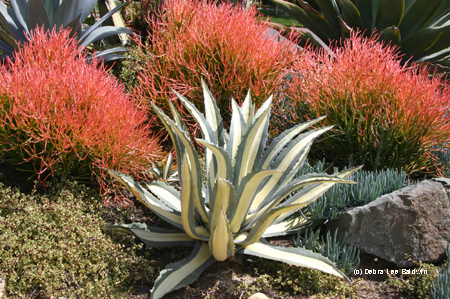
Here’s one firewise garden vignette for frost-free areas: Agave americana ‘Mediopicta Alba’ surrounded by Euphorbia tirucalli ‘Sticks on Fire’ (background), blue Senecio mandraliscae (groundcover, foreground right) and creeping elephant’s food (Portulacaria afra ‘Variegata’).
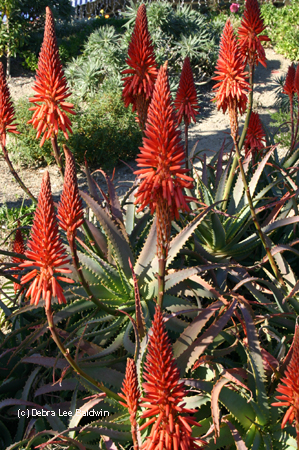
Aloe arborescens blooms in January; it’s the plant that protected Suzy’s art studio. The mounding succulent is common throughout Southern California, is easy to grow, and like most succulents, can be propagated readily from cuttings.
If you live in SoCA and are concerned about wildfire, I’m teaching a Firewise/Waterwise Landscaping class at Quail Botanical Gardens, September 20. Please join us!
My goal is to share the beauty of waterwise, easy-care succulents in gardens, containers and landscapes via blog posts, newsletters, public speaking and workshops, photos, videos, merchandise, and social media (Facebook and Pinterest). My books: Designing with Succulents, Succulent Container Gardens, and Succulents Simplified. www.debraleebaldwin.com
